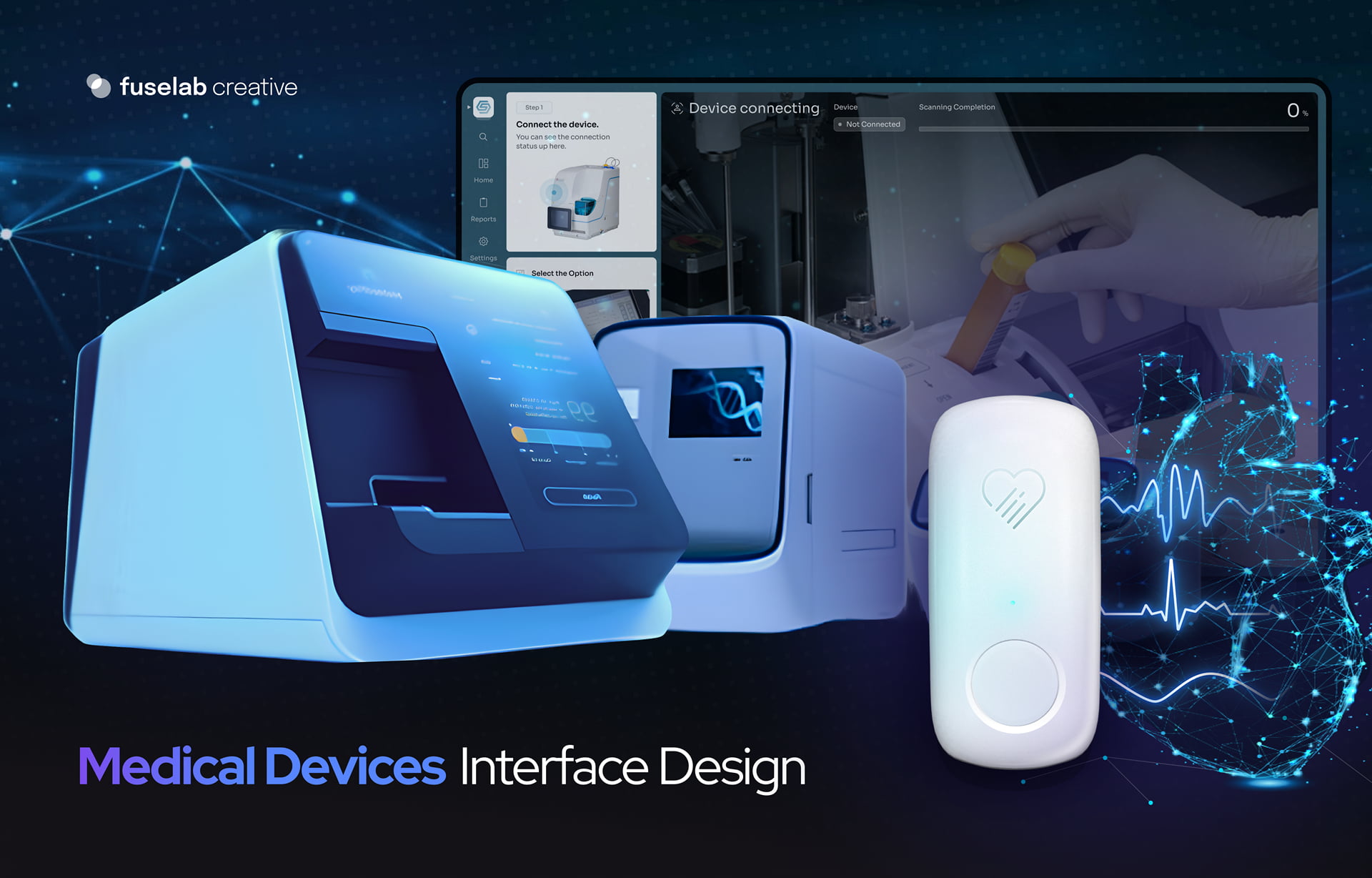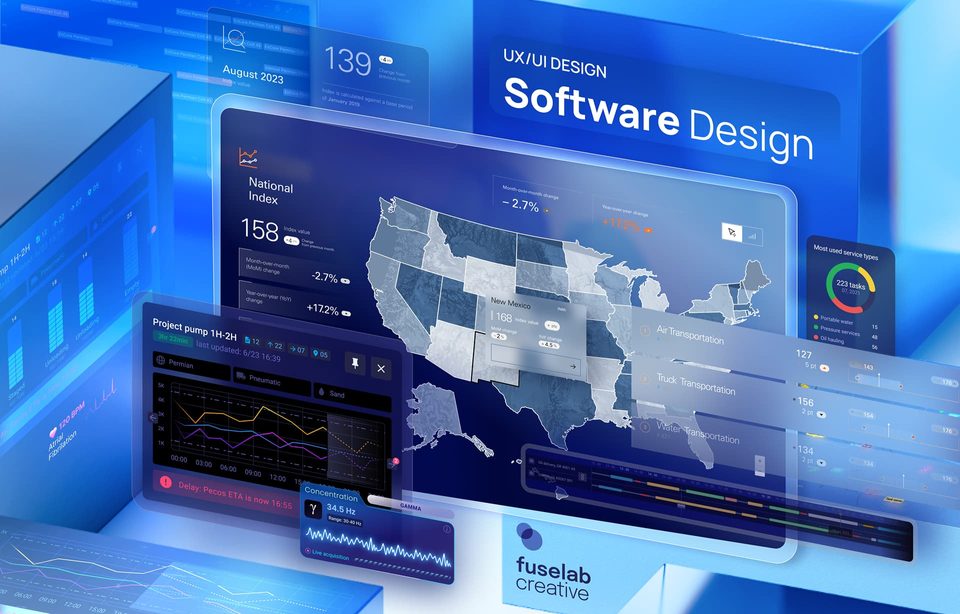Designing for Health: The Crucial Role of Medical Device UI/UX Design

Often, we are so accustomed to equating the medical profession with all that is functional and simple that we forget that all those beeping monitors are being used by people like us. People who appreciate and expect a good user experience, clarity, and quickness.
As technology becomes more and more embedded in the medical ecosystem, it has become critical to ensure that the multi-generational and multi-disciplinary professionals who use it are provided with a system that enables speed, understanding, and accuracy.
This is where medical device UI, or user interface design, comes into play.
What is Medical Device UI design?
Designing interfaces that put users at the heart of the process is critical for ensuring that medical institutions provide the best patient care and outcomes possible.
Medical device UX design refers to building medical devices that give their users an intuitive and error-free handling experience. It starts with analyzing how a device will be used, who will be using it, and under which circumstances. At a deeper level, it also takes into account the expectations, behaviors, and perceptions of its users. These insights then form the core of the principles that inform the interface design.
The goal is to make devices that simplify user interactions and enable them to achieve efficient results in stressful and time-constrained situations. Here are some well-known medical device interface design advantages:
The growing digitization of the healthcare and medical industries has increased the dependence on digital devices all across the healthcare sector. No medical department or sector has been left untouched by technology, making it imperative that professionals faced with a multitude of devices can manage them efficiently and with minimal training.
Enhancing Usability
Human-centered medical device design requirements are laser-focused on making these devices user-friendly in a medical setting. In high-pressure situations, ensuring devices come with intuitive and efficient interfaces can affect patient outcomes. Following the best practices of medical device UI/UX, manufacturers ensure that users can learn how to operate devices quickly, with less training, and manage them without any loss of time and hopefully with improved diagnosis accuracy.
Ensuring Patient Safety
The clarity of UI design in medical devices has a direct impact on patient safety. Inaccurate data entry, miscommunication, or misunderstanding of device readings can lead to medical errors, which can have serious implications for patient safety.
In critical healthcare settings, a monitor that gives information clearly and without any scope for confusion is a must.
Realizing the Potential of IoT and Wearable Devices
Medical device interface design also has clear value for the burgeoning homecare device segment, where non-medical users need more support and guidance to use the machines safely.
With emerging tech trends such as the Internet of Things (IoT) and wearable health tech, medical device UI design must also consider consumer-grade devices. The challenge here is to create interfaces that are not only functional but also user-friendly enough for novices.
Reduce cognitive load
Over the years, the MedTech industry has slowly added different devices from a multitude of manufacturers. A thoughtful device interface can help professionals work faster on multiple monitors. An easy-to-read and consistent visual language, such as color coding and familiar iconography for the devices reduces mental load and improves efficiency.
Design best practices for user-friendly medical device interfaces.
We know how important a well-designed device interface is to the smooth functioning of the healthcare industry, but what is a good medical interface UI/UX, and how do you go about designing it?
Below, we’ve summarized eight industry best practices for designing medical device interfaces:
1. User-centered design process
Make sure to place the user at the center of your design process by thoroughly researching their needs, preferences, and limitations through methods like user persona creation, surveys, user journey mapping, and usability testing.
2. Keep it clutter-free
Often, the need to cram information and data takes over the user interface and leads to an overloaded screen that makes it hard for people to find information quickly and accurately.
The key to providing error-free information on the go is to keep the design clean and clutter-free with simpler graphics, larger text, and focus on visual and contextual hierarchy in the content.

3. Intuitive and clear navigation
Moving from one place or step to the next should be clear and obstacle-free for medical personnel. Implement a logical and intuitive information architecture to help users easily find and understand critical data or features.
4. Visual balance and consistency
A good practice in medical device user interface design is to bring a sense of consistency and standardization along with visual balance. Spread the content evenly, make sure your content follows the same grid and margins, use a limited color palette, maintain a standard color code, and follow the same style for typography, headings, icons, and more.
5. Adhere to relevant regulatory standards
Make sure your UI/UX incorporates any guidelines that are applicable to your industry and location, such as the FDA’s Human Factors Engineering Guidelines and ISO 62366.
6. Build-in visual and audio feedback
Build-in haptic, visual, and audio feedback to confirm actions and ensure that users receive immediate responses to their interactions with the device. In case the situation requires any alerts, warnings, or critical information to be given, they must be communicated clearly and in a manner that is impossible to overlook.
7. Create a responsive (and/or adaptive) design
Hospital app design should be seamless across a variety of devices, and its interface design should be built on a responsive framework that is adaptable to various screen sizes and orientations.
8. Test with end users
The entire process must include input and support from teams across design, engineering, and end users. It is important to continuously conduct usability testing with actual users to identify and address any issues while the interface requirements specifications are being developed, rather than at the end of the process.
Some well-known examples of successful medical device UI design.
The Apple Watch is a great example of the impact of design on medical device functionality and popularity. Its user-friendly interface and seamless integration with health monitoring features have made it an industry favorite with users in the home healthcare segment. And that’s not all; its popularity is matched by the medical value it provides; the watch serves as an important tool for users to track their health and wellness.
(If you are looking for a minimal and fully functional health monitor, then do take a look at this health monitor application we built for one of our key clients.)
Another excellent example is the Philips IntelliVue Patient Monitor, which has brought intuitive user interface solutions to the medical device industry. The sleek design follows all the best practices we listed above and provides healthcare professionals with real-time patient data in an easily interpretable format.

Trends to keep in mind while designing your medical device UI
While medical devices and their functionalities might not change at the breakneck speed associated with digital tech, they do get more complex as emerging technologies organically integrate with them over time. Here are some current technology and consumer trends that you should keep in mind while designing the UI for medical devices.
Biometric security
As data privacy and system security concerns rise, so do the conversations around safeguarding networked devices. Biometric security is already an established, easy-to-use, and tested security technology, and we will see a surge in including its features on medical devices.
Voice-activated or controlled interfaces
Voice-assisted devices such as Alexa and Siri have gained more than a foothold in our daily lives; more than one billion voice searches take place every month, and the number keeps increasing. The trend is now also well on its way to entering the medical ecosystem and devices, and the UI of the near future will have to consider voice queries as part of its design.
Conversational chatbots
Lately, NLP, or Natural language processing, has matured enough to make conversing with a chatbot reasonably natural, deeply informative, and quick. Chatbots are already being used in the healthcare industry to automate a lot of queries, and we will see this trend grow to include interactions with medical devices, between patients and automated systems, and for querying databases.
Virtual and augmented reality
VR and AR technologies have found acceptance in the medical profession and are very successfully integrated into the training of medical professionals, for example, for providing immersive training in surgery.
However, AR and VT can play a bigger role in healthcare by providing immersive experiences that help patients understand and manage their health status.
Empowering Patients and Providers with User-Focused Interface Design
The MedTech market is projected to touch $799.67 billion by 2030, and for the manufacturers, a key point of differentiation could be UI/UX design that makes professionals and patients comfortable with their devices.
If you want to align your medical devices with the latest in interface design, then let’s get on a call and find out how you can leverage our extensive medical device interface design skills for your business.

Browse more

Data Visualization Trends 2024
